What is a silvopasture?
Silvopasture is a type of agroforestry system with potential to deliver multiple outputs. Silvopastures are characterized by the intentional integration and management of trees, forages and livestock. Silvopastures have been broadly accepted as an integrated approach to sustainable land management with potential to enhance ecosystem services in a multifunctional working space, while providing options to mitigate and adapt to climate change.
In addition, silvopastures can help diversify farm income; for example, while grazing livestock can generate annual income, tree crops and products (e.g., nuts) could also provide short- or longer-term economic output for the farm.
The intentional integration of trees and forages has been practiced in different parts of the world for decades or even centuries. In the U.S., this practice is most typically associated with pine systems in the Southeast coastal plain, but the practice is used in the Pacific Northwest under spruce as well as in hardwood-growing regions of the country.
Silvopasture is not turning livestock loose in the woods. In fact, silvopasture can be considered a system requiring a more intensive management, where the different components (i.e., livestock, trees, forages) and its interactions need to be accounted and managed for. For example, the arrangement of trees in the landscape is a key influential feature of silvopastures (Figure 1).
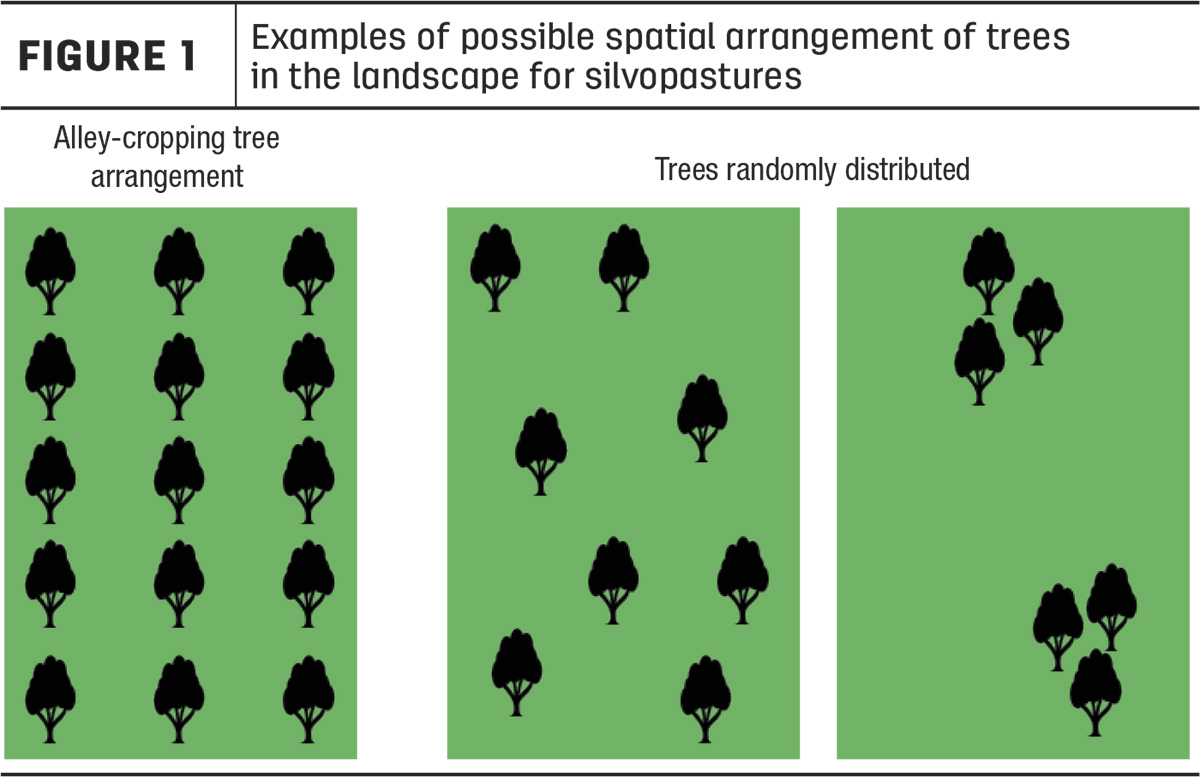
Silvopastures can be successfully established and managed by planting trees and forages at the same time, by planting trees into existing pastures or by thinning existing tree stands and planting forages. If the goal is to keep a productive forage-livestock enterprise over the length of the rotation, lower tree densities are needed. This will require greater efforts to protect, prune and thin the tree stand, but this intensive management has a positive trade-off in production of higher-value logs. Additional factors in thinning decisions include debris management, pruning requirements and tree crop production.
The potential of silvopastures to deliver ecosystem services is directly related to the interaction of its components within a specific environment. Consequently, synergies and trade-offs are influenced by specific management decisions and the selection of the components. For example, in the “tall fescue” belt U.S. region, the understory forage component of a system with pines as the tree component could either be a warm- or a cool-season forage (Figure 2).
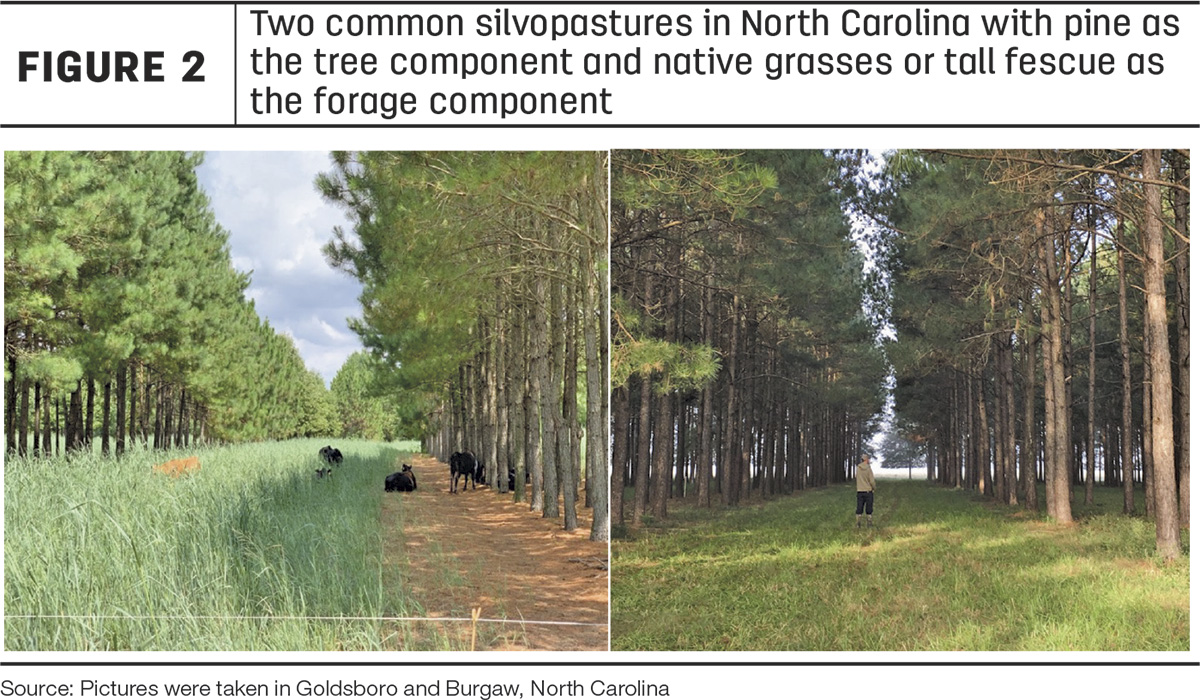
What are the effects of trees on understory forage productivity, microclimate and livestock responses?
For many, trees will first be part of an animal comfort strategy – to relieve heat stress in summer or to provide windbreaks and shelter in winter – or as secondary feed sources (i.e., leguminous trees). Others may be as interested in tree products, whether marketed as commodities (e.g., pine straw or greenery, nuts or fruits) or as value-added goods (e.g., wreaths, ciders, acorn-fattened or apple-fattened hogs). Because no tree species will meet all these criteria, selection should be a “best match” with the producer’s goals and resources.
The presence of trees in the landscape may result in competition for nutrients, water, light and sometimes allelopathy, to the companion forage species; hence, competition between tree growth and forage growth must be carefully managed. Some tree species have physical characteristics such as deep-rooting habit, late leafout and early leaf drop, and an open narrow crown. Forages can be annual or perennial, cool- or warm-season. However, pasture production might not be reduced when trees and forages are efficiently integrated into silvopasture systems.
In terms of livestock responses, trees in the silvopasture potentially affect microclimate, mitigating heat stress for grazing livestock; specifically, through shifts in understory air, temperature, humidity and provision of shade and shelter for livestock. However, the effects are variable depending on the components of the silvopasture; in addition, in a given silvopasture, the interactions among specific components can change over time, as tree growth accumulates over time. Increased weight gain, milk yield and conception rates have been reported for cattle or sheep grazing pastures with trees in warm environments.
The temperature-humidity index (THI), an index that combines air temperature (ºF) and relative humidity (%), has been historically used as a measure of thermal comfort for livestock. Dairy livestock productivity may be affected when a THI threshold of 72ºF is reached, resulting in economic losses; however, threshold vary by type of livestock and exposure time. In the southeastern U.S., THI of 72ºF or greater could potentially be reached for at least about a third of the year (about 100 to 150 days). Thorough accounting of heat stress would require weather information from the farm (as opposed to regional weather stations), thus accounting for length and strength of the heat period and information on the existence and use of heat management measures. This information is of particular importance to capture the potential benefits of silvopastoral systems in the southeast U.S.
Forage productivity, light environment, and microclimate in a North Carolina silvopasture
Forage accumulation, forage nutritive value and microclimate were measured in a silvopasture located in Goldsboro, North Carolina. As a reference, the trees were established in 2007 with an alley-cropping design. The three tree species were: Pinus palustris (PP; longleaf pine), Pinus taeda (PT; lobloblly pine) and Quercus pagoda (QP; cherrybark oak); the two alley widths were 40 and 80 feet between lines of trees. Each tree line consisted of three rows of trees planted in a triangular spacing with distance between trees of 6 feet in each row and 6 feet between tree rows. The forage component consists of a four-way mixture of native warm-season grasses. The grasses were big bluestem (Andropogon gerardii, "Eastern" Kentucky origin), gamagrass (Tripsacum dactyloides, Missouri origin), indiangrass (Sorghastrum nutants, "North Carolina ecotype"), and switchgrass (Panicum virgatum, "Alamo") planted in the summer of 2014. Tree heights, as of 202 8, were 97 feet PT, 64 feet for PP and 50 feet for QP. Diameter at breast height was 7.8, 5.9 and 4 inches for PT, PP, QP, respectively.
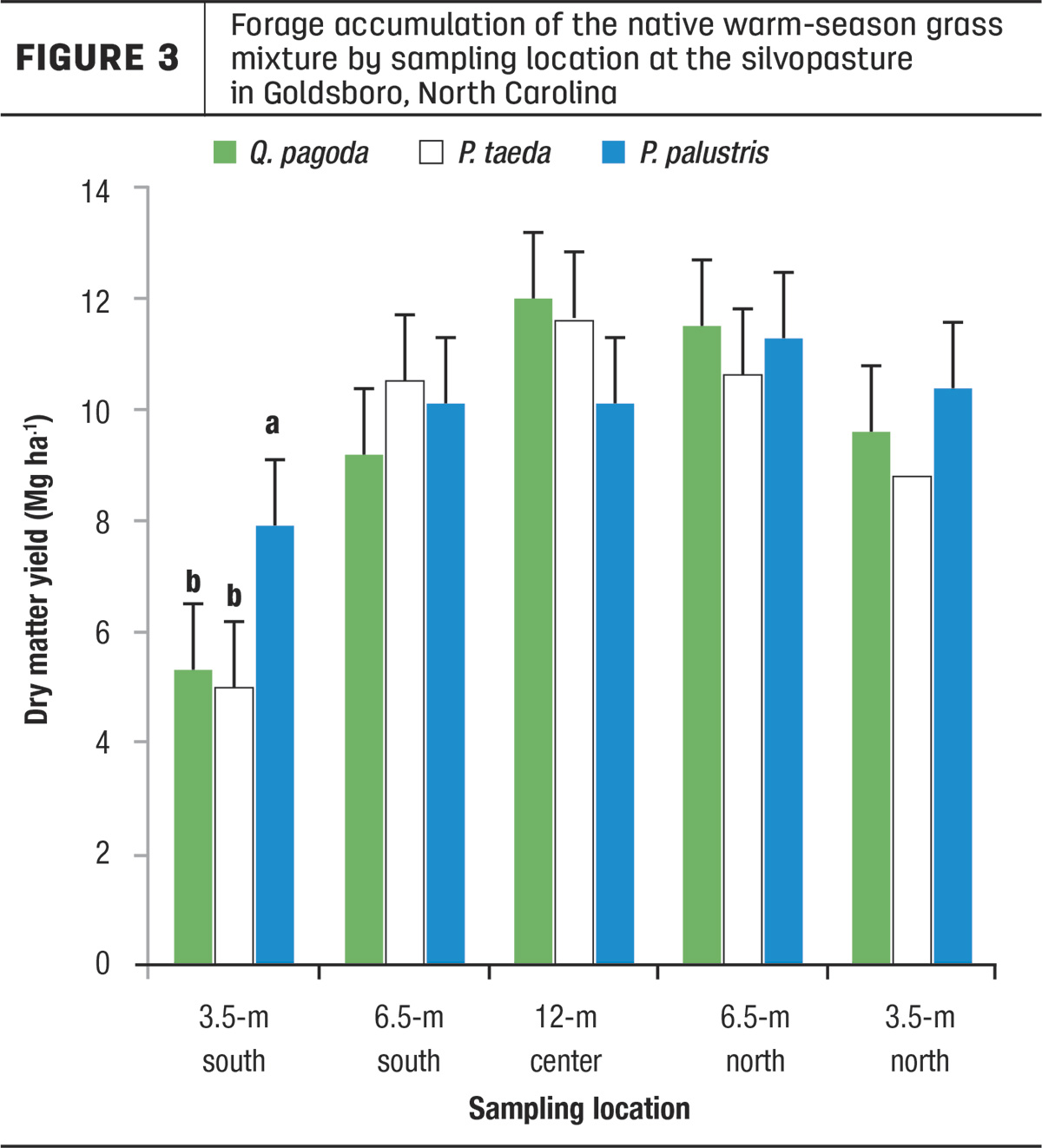
Forage productivity and nutritive value
With the exception of the 3.5-m south sampling location (Figure 3), we did not detect differences in forage accumulation due to tree species at the other sampling locations. Forage accumulation ranged from 4.3 to 5 tons per acre. Nutritive value estimates of total digestible nutrients (TDN) and crude protein (CP) were similar in the three tree species systems. Concentrations of TDN and CP ranged from 54.3 to 59.3 and from 5% to 7.7%, respectively. According to the National Research Council (NRC) (1996), the CP concentration needed to meet the requirements of a non-pregnant non-lactating mature cow is 8.9%. The low CP and TDN concentrations in this case are due to the harvesting schedule that consisted of two clippings per year (at mid- and end-season). If the forage was grazed, then defoliation should be started earlier in the season, not allowing the forage to mature, and consequently resulting in greater nutritive value estimates.
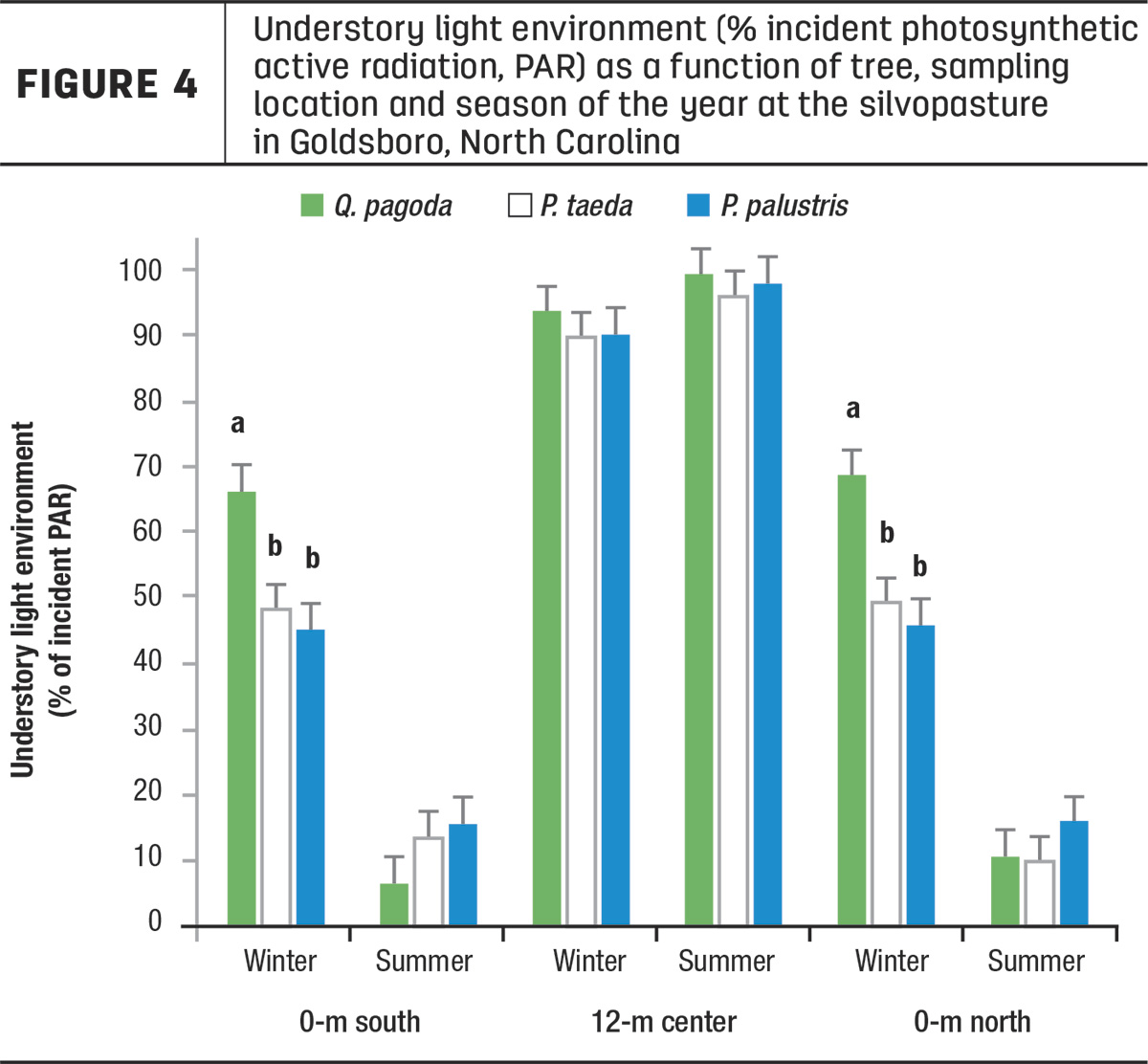
Light environment
For the Goldsboro site, light environment was greatest at the center of the alley, and it was lower and it varied as a function of season of the year at the 0-m north and 0-m south locations. The average maximum daily solar radiation per month measured at solar noon ranged from 492 to 1,152 W/m2, with the lower values occurring in winter (between November and February). Understory light environment (measured as relative photosynthetically active radiation [PAR] around noon) ranged from 6.3% to 99% (Figure 4). At the center of the alleys, light environment was 90% or greater for all tree species across sampling seasons (winter and summer). In contrast, at sampling locations 0-m north and 0-m south, the understory light environment during summer was 15% or less for all tree species; however, during winter the understory light environment was greater for QP (approximately 67% of incident PAR) compared to PP and PT (approximately 47% of incident PAR). These results highlight the potential of this specific silvopastoral system design (i.e., alley-cropping) to provide year-round areas of high and low light (or shade) environment to protect livestock from direct and indirect solar radiation.
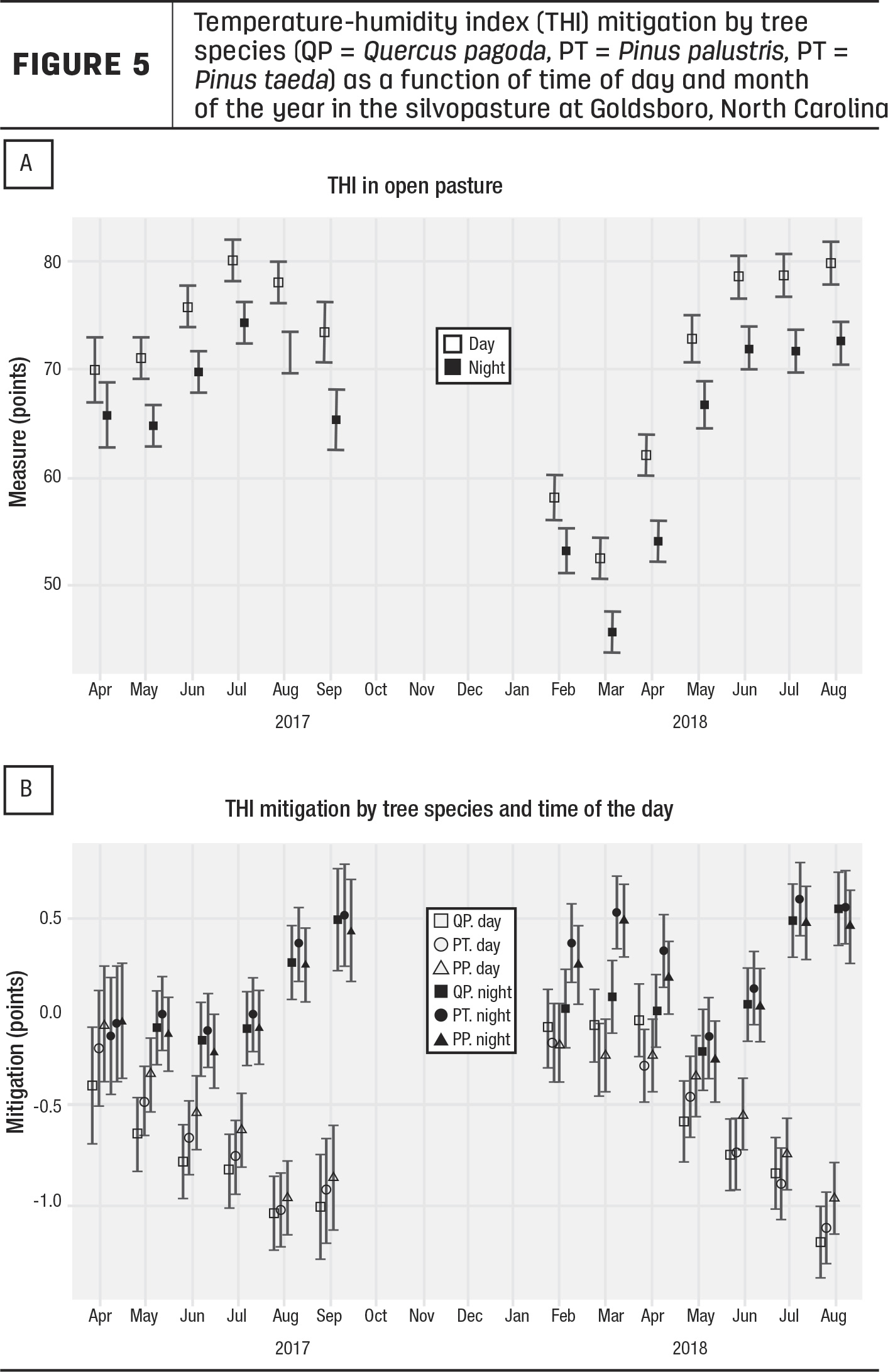
Temperature-humidity index
In general, the THI in the open pasture (no trees) was greater during the day (Figure 5A). Daylong (day and night) temperature, relative humidity and THI were greater during spring and summer months versus fall and winter. The mitigation potential of trees to temperatures, relative humidity and THI are presented in Figure 5B. The mitigation estimates are reported as the difference between the open pasture and under a specific tree in the corresponding time of day and year-month. There were no differences in THI mitigation among tree species and mitigation values were greater during the summer months. Greatest mitigation values were +0.5 point during the night and -1 point during the day.
Although temperature, relative humidity and THI had relatively moderate mitigation effects, the presence of shade (Figure 5) available to grazing livestock should still be considered significant in grazing systems in the southeastern U.S. Absorption of heat from incoming solar radiation by livestock should be considered in addition to ambient air temperature. Other measures of heat stress are needed to fully characterize this phenomenon, with the ultimate effects on animal responses measured for a specific type and breed of livestock.
The effects of heat stress on livestock, and the benefits of providing shade, manifest in multiple physiological, metabolic, reproductive and behavioral responses. Cows provided with shade have significantly lower respiration rates and core body temperature than cattle without shade in warm summer conditions. Utilization of shade by cattle increases as average solar radiation increases and it could reduce total heat load by 30% to 50%. In a West Texas feedlot with artificial shade, Angus-crossbred and Charolais-crossbred heifers reached their target bodyweight three weeks earlier compared to unshaded cattle.
Take-home messages
Management is integral to the success of silvopastures. A tacit challenge for implementation of silvopastures is a willingness to manage complexity and to think in time-period scales, which tend not to be the common approach in the agricultural community. Silvopastures, however, offer great potential to increase productivity and diversify farm income, through intentional integration of trees, forages and livestock.
References omitted but are available upon request by sending an email to the editor.











